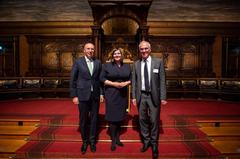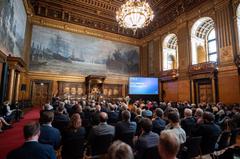URL: https://www.desy.de/news/news_search/index_eng.html
Breadcrumb Navigation
DESY News: PETRA IV – Setting out into a new era of research and innovation
News
News from the DESY research centre
PETRA IV – Setting out into a new era of research and innovation
The world’s best X-ray microscope is to be built in Hamburg. The facility, called PETRA IV, will provide 3D images of the nanocosm and offer insights into materials and biological structures with unprecedented precision – from the structure of pathogens, through catalysts, to innovative microchips and quantum materials. “With PETRA IV, we are developing a crucial tool for Germany’s capacity to innovate in the 21st century,” pointed out Helmut Dosch, the Chairman of DESY’s Board of Directors. The Hamburg Senate had invited DESY to present the project at the city’s town hall on Tuesday.

Nobel Laureate Stefan Hell, Science Senator Katharina Fegebank and DESY Director Helmut Dosch (from left) in the large ballroom of Hamburg City Hall. Photo: DESY, Daniel Reinhardt
The analytical research carried out at PETRA IV is expected to contribute decisively to identifying solutions for a climate-friendly and sustainable economy that preserves natural resources. In a recent study, DESY examined which technology trends are expected over the coming decades. These will serve as guidelines, together with extensive workshops with scientists, in tailoring the analytical methods and tools provided by the intended large-scale facility to the needs of research and industry. It will for example be possible to study catalysts, functional materials or the emergence of corrosion under natural and near-natural conditions in 3D, live and on all relevant spatial and time scales.
“Thanks to these unparalleled analytical capabilities, it will be possible to achieve ground-breaking results in a much shorter time,” said Thomas Blatt, Principal Scientist with the Beiersdorf Group, in a video message. “The semiconductor industry, for example, can benefit directly from studying the structural properties of new materials. Such unique analytical tools are essential for scientific progress.”

At the invitation of the Hamburg Senate, DESY presented the project on Tuesday in the large ballroom of the City Hall. Photo: DESY, Daniel Reinhardt
“We closely combine outstanding fundamental research with applied research topics that are central to the economy and to society,” Dosch explained. “Our goal is to turn PETRA IV into the heart of a unique research-innovation ecosystem – a powerful generator of innovation.” A symposium held to mark the occasion illustrated that PETRA IV’s outstanding analytical facilities will provide researchers in numerous disciplines – from physics, chemistry and biology, through medicine, engineering and geosciences, to art and cultural research – with previously unattainable insights and help companies develop their innovations.
In a video message to the symposium, which was held at DESY in the afternoon, the President of the Fraunhofer Society, Reimund Neugebauer, said: “Here at Fraunhofer, we are extremely pleased that DESY is intending to massively expand and optimise its cooperation with applied research and industry.”
DESY will offer researchers from science and industry additional services associated with the available analytical techniques, such as sample preparation, data storage and analysis. “As a national analytical centre, DESY will offer researchers and companies a significantly expanded range of services, to accelerate innovation and scientific solutions,” Dosch announced.
“With PETRA IV, we are completely rethinking large-scale research at DESY,” summarised project manager Harald Reichert. “PETRA IV is a long-term investment in the future – it will remain the flagship of X-ray research for decades to come and an important building block for Germany to increase its technological independence.”
Further information:
The PETRA IV project involves building a new state-of-the-art facility in the existing 2.3-kilometre particle accelerator tunnel housing PETRA III. The upgrade and the subsequent operation will be particularly energy- and resource-efficient. This is possible thanks to new accelerator technologies, among other things.
The complex project is still at the technical planning stage. Among other things, the technical construction plans for the facility, the construction schedule and the planned costs are currently being established. DESY plans to apply for project funding in early 2023. The federal government and the state of Hamburg will then decide on the scope of their financial support.
As one of the world’s leading accelerator centres, DESY has more than 60 years of experience in the construction and operation of top-class, complex, large-scale scientific facilities. The X-ray source PETRA III, for example, was successfully completed in 2008 and the free-electron laser European XFEL in 2017, on schedule and within the budget.
The accompanying scientific symposium held at DESY’s site in Hamburg-Bahrenfeld had the motto “PETRA IV: New Dimensions in Research and Applications”, and some 150 experts from a wide range of research fields registered to discuss the PETRA IV project and the multitude of completely new findings that the facility will make possible, for example in the field of new materials.



